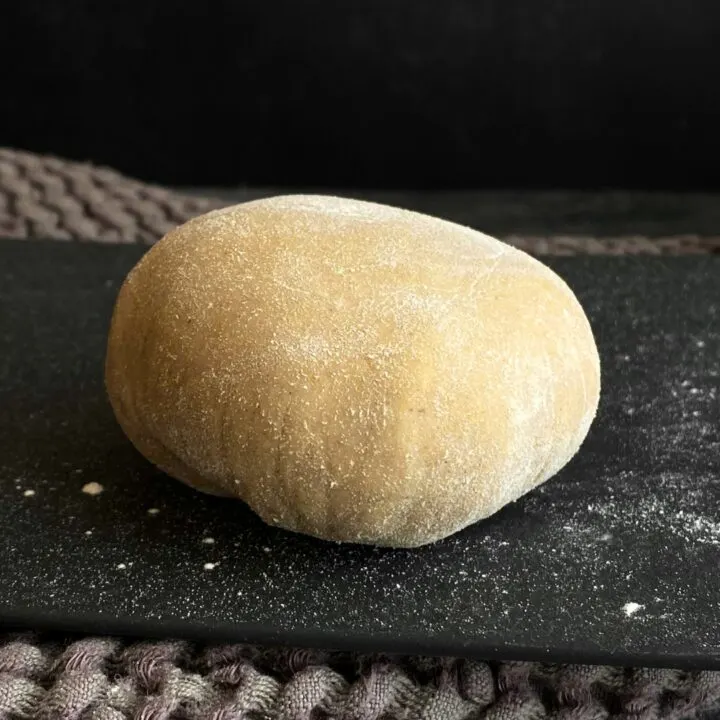Gluten is essential to pasta dough because the protein provides elastic and plastic properties.
These properties are essential because a thick dough ball is supposed to become thin noodles. The dough is subjected to extreme stress during the shaping process, so it must have a particularly elastic and malleable structure to prevent it from deforming.
In my article on the production of gluten-free pasta, I have already gone into detail about the individual preparation steps.
In this article, you will find a collection of all gluten-free pasta doughs that worked for me. Have fun!
⬇ Pin it for later!

Best Gluten Free Pasta Dough for Beginners (Step by Step)
Making gluten-free pasta dough is not easy; it is often too crumbly and sometimes becomes as hard as concrete. But, so far, I have achieved the best result with store bought gluten-free flour blend. The dough is easy to knead and even elastic enough to form tortellini. The one I chose was gluten free flour from Schär.
Since i live in Germany, you might not find this exact one. To replace it, you can choose any gluten free flour and add 2 tsp xanthin gum.
Best gluten free pasta dough:
4 Servings
- 14 ounces (400 g) of gluten free flour (I use Schär)
- 4 eggs (7 ounces or 200 g without shells)
- 1 tbs olive oil
- 1 tsp salt
- Add 2 tsp xanthan gum to get the best result
(Find my exact product recommendations in the recipe card)
If you want to discover more gluten-free dough recipes, look further down!
For this recipe, you will need the following:
- A large worksurface
- A dough scraper
- A fork
If you own a food processor, you can make your job easier. More on that later in the article.
Step 1: Empty the flour onto the work surface and form a well.
First, empty the flour onto the work surface and add the salt and eggs.
Then whisk the eggs and gradually work the flour from the outer wall into the egg mixture, creating a viscous liquid.

Step 2: Whisk the eggs and gradually mix in the flour.
Then whisk the eggs and gradually work the flour from the outer wall into the egg mixture, creating a viscous liquid.
Scrap off residues on the fork to not waste anything, and continue with the dough scraper or your hands.
Thoroughly mix in all the flour until a crumbly mixture forms. Then, using your hands, bring the crumbs together to form a lump.
If the mixture does not want to form a lump, you can add a little water in a large amount (picture 2).
In the next step, you will incorporate the remaining dough crumbs on the work surface into the dough.
You can find tips against crumbly pasta dough if you need help with this step.

Step 3: Knead the dough for 8 minutes until the surface is smooth.
Now you need to knead the crumbly mass into a homogeneous dough.
There are several kneading techniques, one of which I find particularly compelling:
Apply forward pressure to the dough with the heel of your hand. Then, pull the dough back again with the other hand, turning it slightly by about 45°. Repeat the process until all the dough crumbs are incorporated.
Knead the dough for at least 8 minutes or until the surface feels silky and no longer sticks.
If the dough still sticks to your hands, you must sprinkle flour on the work surface and work it in.

Step 4: Wrap the dough in plastic wrap and let it rest for 30 minutes.
Once the pasta dough has the right consistency, you can wrap it in plastic and rest it for 30 minutes.
The resting time is essential because it rearranges the protein chains responsible for the dough’s stretchiness. Only this allows the dough to be rolled out thinly without returning to its original shape.
You have successfully made a gluten-free pasta dough!
Now all you have to do is shape it into delicious pasta and prepare a suitable sauce.
Here’s a detailed tutorial (with a video) on how to make gluten-free pasta:
- Make gluten-free pasta yourself (with and without eggs).
Variations for pasta dough without gluten
The basic recipe for pasta dough with gluten-free flour from Schär is the best and easiest I have found.
However, there are other attractive alternatives with different types of flour that are worth trying.
Gluten-free pasta dough with red lentils.

Thanks to their high protein and fiber content, lentils are very healthy. This gluten-free pasta dough even has a double health effect: the dough quickly becomes very firm and is, therefore, damn hard to knead. So be prepared to burn some calories! But it works, and the result is always worth a try!
Pasta Dough with Red Lentils:
4 Servings
- 17.6 ounces (500 g) of red lentil flour
- 5.3 ounces (150 ml) of water
- 1 tsp (4 g) Salt
- 1 tbs olive oil
(Find my exact product recommendations in the recipe card)
Gluten-free pasta dough with chickpeas

Chickpeas are technically great for pasta dough because they have a lot of protein that mimics the effects of gluten.
However, the dough has a peculiar taste that you might not like. Therefore, I prefer the recipe listed in the next section: a mixture of buckwheat and chickpeas.
Pasta Dough with Chickpeas:
4 Servings
- 14.1 ounces (400 g) of chickpea flour
- 4 eggs (7 ounces or 200 g without shells)
(Find my exact product recommendations in the recipe card)
Gluten-free pasta dough with buckwheat and chickpea

Buckwheat is one of the best flour for gluten-free noodle doughs. In Japan, they use it traditionally for soba noodles.
Pasta Dough with Chickpeas and Buckwheat:
4 Servings
- 3.5 ounces (100 g) chickpea flour
- 11.3 ounces (320 g) buckwheat flour
- 7.8 ounces (220) of water
- 1 tsp (4 g) of salt
(Find my exact product recommendations in the recipe card)
This dough combines chickpea flour’s binding properties and buckwheat’s tangy taste.
Recipe: 100 percent buckwheat pasta dough
Making this dough requires a lot of practice because buckwheat hardly provides enough elasticity to form a good dough. As a result, it remains highly crumbly and difficult to roll out without tearing.
I have not succeeded in forming beautiful noodles from it, but it is certainly possible because, in Japan, soba noodles with 100 percent buckwheat are made and served daily (by masters).
Therefore, this recipe also deserves a place on this list, although I could only achieve moderate results.
Pasta Dough with 100 % Buckwheat Flour:
4 Servings
- 14 ounces (400 g) of buckwheat flour
- 4 tsp of salt
- 7 ounces (200 g) of water
(Find my exact product recommendations in the recipe card)
Recipe: pasta dough with buckwheat and wheat flour (contains gluten).
The reason I show a mixture with wheat in a post for gluten-free pasta dough is this:
According to this article from Schär, even people affected by gluten intolerance can tolerate a small amount of gluten daily.
Because the following pasta dough is about four times below the specified limit of 10 mg gluten (calculated per person) and the small amount of wheat already works wonders in dough structure, I also decided to include this recipe.
Pasta Dough with Buckwheat and wheat flour:
4 Servings
- 11.3 ounces (320 g) of buckwheat flour
- 3.5 ounces (100 g) of all purpose flour (or Italian Farina Tipo 00)
- 7.8 ounces (220) of water
- 1/2 tsp (4 g) of salt
(Find my exact product recommendations in the recipe card)
Gluten-free pasta doughs for the pasta maker.
Do you own a fully automatic pasta machine and are looking for suitable recipes without gluten? I have already created a list of dough recipes for the pasta maker.
Feel free to comment if you have any questions or suggestions about this post!
Here are three other articles that might interest you:
- Make your pasta dough: the complete tutorial
- Gluten-free pasta dough with chickpea flour
- Vegan pasta dough with red lentils (gluten-free)
Have fun making your pasta!
⬇ Pin it for later!


Best Gluten Free Pasta Dough (+5 Alternatives)
I have tested over 10 recipes for gluten-free pasta dough. This recipe with gluten-free all-purpose flour from Schär gives by far the best result.
Ingredients
- 14 ounces (400 g) of gluten free flour (I use Schär)
- 4 eggs (7 ounces or 200 g without shells)
- 1 tbs olive oil
- 1 tsp salt
- Add 2 tsp xanthan gum to get the best result
Instructions
- Empty the flour onto the work surface and form a well.
- Whisk the eggs and gradually mix in the flour.
- Knead the dough for 8 minutes until the surface is smooth.
- Wrap the dough in plastic wrap and rest it for 30 minutes.
